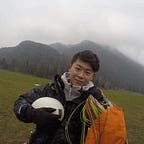Brief: Design a sensory based ritual or experience for the characters of the Xenosomatics world/culture.
Team: Alex, Rikkie, Sanya, Binru
Introduction
This week we have a guest lecturer — Susan Ploetz, an artist-researcher working with somatics and live action role plays (LARP). In the seminar, she introduced the somatics and LARP to us. We learned how to combine somatics and larping in the different design context through a simple somatics activity.
Susan put forward a virtual Xenosomatics world, and we should use the larping frame and somatics to design an experience of connecting in the Xenosomatics world.
Double Diamond design model
The British Design Council put forward double Diamond, and the design model divides the design process into four stages: Discover, Define, Develop and Deliver (Design Council). The Double Diamond key is that correctly find the problems and solutions through diverging or converging thoughts. We completed our design project with the Double Diamond design model.
Discover
Human and other many alien creatures live in the Xenosomatics world, and they have different lifestyles. Our design project is designing a ritual of interaction for the community, and the different species can join in it. We thought about some features of the most creatures, and they need to get nutrition, make friends, work with different species and have entertainment. Our group found some requirements and problems in these activities. For example, a human may want to feel the different environment on the other planets. Also, the aliens want to exchange their cultures to human, but they use the different communicative means.
Define
Our group found that the different creatures wanted to make friends with each other, but communication is a problem. We also thought about the importance of sense to communication. Therefore, we decided to create a new communicative mean between the different species and help them make friends.
Develop
At first, we thought about visualizing the sound or voice and designing a universal visual language. The different creatures could talk with each other through the universal visual language. Our second idea is making communication with gestures and sound, and the sound is a universal language.
According to our evaluation and tutors’ feedback, the second idea was better. The first reason was that it was difficult to achieve sound visualization. We just could make colour to change as the sounds change. The universal visual language lacked the interaction between the different species. In addition, the sounds and gestures were better for building the connection with the senses.
Deliver
Our group wrote the script for the second idea and set up some questions asked by sounds (no human languages) and gestures. In our LARP, we held a “cultural exchange evening” on the earth, and the aliens could talk with humans in the activity. Besides, we prepared some questions about their culture for them, and they could ask each other these questions.
We invited some classmates to attend and test our LARP. They gave us some useful feedback after testing the LARP. First, the volunteers thought the questions were too difficult to express. Second, they hoped we should give players more introduction to the LAPR.
Our group finally decided to reduce the use of hand gestures, because using them affects the player’s ability to make sounds. We hoped the players just focus on making sounds, and then they could use some objects to make more sounds. In the end, we just allowed players could use gesture when they finish their questions.
Sanya drew the four different cartoon characters for our LARP.
Feedback and reflection
We received some valuable feedback from Susan, our tutors and players. They like the process of rituals in our LARP. Susan said the ritual in the end, which made people feel the connection with each other well. The behaviour of ritual is an excellent way to make users immersed in the virtual world’s experience. They also mentioned that our LARP still provides more guidance to the player when they explored the virtual world.
What I learned from LARP
In this project, our group learned knowledge about somatics and built a LARP. I think that immersion is essential to user experience in some situations, especially for LARP. Immersion makes people focus on the current situation (created by the designer) and feel happy and satisfied while forgetting the real-world situation (Lidwell, 2015). Somatics can help us find immersion. In my opinion, an excellent immersion experience includes rich sensory experience and cognitive experience. By building the LARP, I think designers should give users some very clear goals to create an immersion experience. Designers should also combine the users’ behaviour with their senses to improve the users’ attention in the immersion experience. In our LARP, we write a detailed script that involves every goal and tries to make players focus on their hearing sense. Also, I found that designers should try their best to eliminate all disturbs. For example, our group hopes players focus on making sounds, limiting them to use gestures.
Reference
Design Council. (2019) Design Council’s evolved Double Diamond. Available at: https://www.designcouncil.org.uk/news-opinion/what-framework-innovation-design-councils-evolved-double-diamond (Accessed at: 21 March 2021).
Lidwell, W. (2015) The Pocket Universal Principles of Design. Laguna Hills: Quarto Publishing Group USA.
